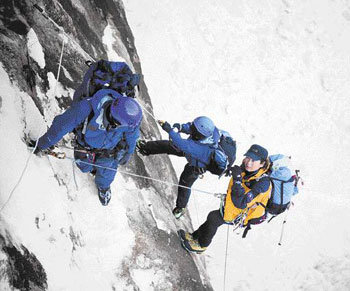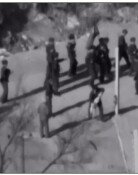Korean Team to Cross Bering Strait on Foot
Korean Team to Cross Bering Strait on Foot
Posted February. 15, 2007 07:15,

Isnt the Bering Strait the place where someone like Cho Oh-ryeon, dubbed Asias seal, should try to cross? This is what many readers said after Dong-A Ilbo reported that Park Young-seok (44. director at GoldWinKorea, OB of mountaineering club of Dongguk University) was trying to traverse the Bering Strait.
Park himself expressed his concern about his plan, saying, The Bering Strait is at 65-67 degrees north latitude but, due to global warming, the amount of floating ice has drastically declined and changed into something like ice water. Im afraid that I might have to swim more than walk.
The Bering Strait, which was a land bridge during the Ice Age, is the path where ancient Mongoloids crossed over to America from Eurasia. The attempt to traverse the Bering Strait on foot started in 1987 when the Soviet Union and the U.S., which confronted each other over the Diomede Islands lying in the middle of the Bering Strait, tried to improve relations.
So far, there have been around 20 attempts to cross over the Bering Strait including a Korean, Huh Young-ho, who tried in 1994, but only four people have succeeded in crossing over the Strait in two tries.
Back in 1998, Russian explorer Dmitry Shparo and his son Matvey Shparo succeeded in traveling across the strait on foot after departing Russia on March 1 and arriving in the U.S. on March 21. This was Dmitry Shparos fifth try since he first challenged the strait 1987. Another success story goes to a British explorer and a U.S. marathoner, who started from the U.S. last March 17 and finished on March 31, 15 days after they began their expedition.
Both Shparo and a British explorer said, The shortest distance to travel is 88 kilometers but we had to walk more than 300 kilometers in reality. They said that they had to cover more distances as they had to go around by walking on the ice rather than swimming in ice water, and floating ice moved with the tidal currents and wind.
The Bering Strait, whose average temperature in March is 24-26 degrees below zero, is warmer than the North Pole (35 degrees below zero). For this reason, ice is relatively thinner and the ice on which a tent is erected often breaks apart. In addition, high winds at a speed of 50-60 meters per second, blow every day.
Regarding the Bering Straits weather, residents in Russias autonomous district, Chukot, even say that its bad for one month, that its very bad for two months, and that its terrible for the other nine months on its web site.
Polar bears often appear in the strait area. Park plans to rent a hunting gun and carry it with him all the times in Russia in case of a polar bear attack. As bad as the local situation is, Park, the leader of the expedition, and two other expedition members, Oh Hee-joon (37.Alpine team at North Face) and Lee Hyung-mo (28.OB of mountaineering club at Kwandong University), prepared for the journey more than they did for their South and North Pole expeditions.
Starting last month, they built up their physical strength by pulling tires and learned how to sled at Phoenix Park in Pyeongchang-gun, Gangwon Province. They also practiced for the journey by slicing ice with a traditional saw, dressing in dry suits and plunging into ice water at a tributary of the Hongcheon River.
On February 10, Parks expedition finished testing their equipment, including a satellite data communication device, while spending the night in a tent at a temperature of minus 55 degrees Celsius. The expedition team got help from the Korea Cold Storage Corporation located in Nonsan, Chungnam Province. The team tested whether or not a tent, whose bottom is made of life jacket, floats in the Geum River the next day. Park made the life jackets by himself.
Parks expeditionary team will head for Russia in the afternoon of February 16.
jeon@donga.com
Headline News
- Pres. Yoon refuses impeachment documents for a week
- Debate over Lee’s participation causes friction in government consultative body
- Food and dining prices could increase en masse next year
- Foreign couple borrowed over $2 million to buy a Seoul house
- One-third of Japanese companies keep workers employed until 70







